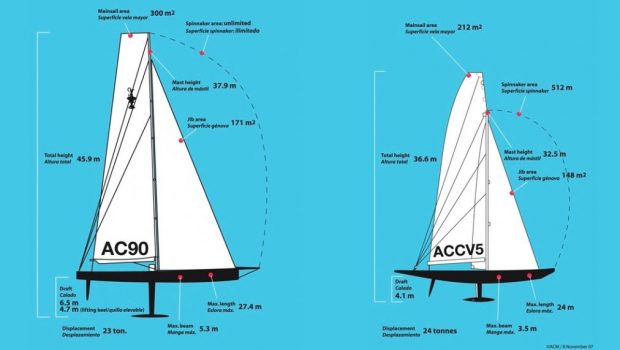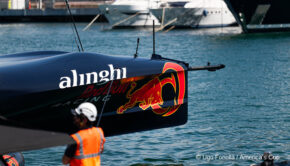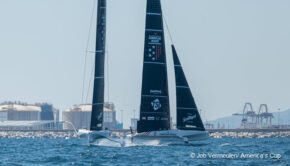America’s Cup: What almost was
Published on April 20th, 2020
For America’s Cup enthusiasts that miss massive monohulls executing crisp crew work and textbook tactics, Dr. Hamish Ross reminisces about what almost was.
After the 32nd America’s Cup match came to an end in 2007 in Valencia, Spain, the successful Defender, Alinghi, announced a new class of yacht would replace the International America’s Cup Class (IACC) for the 33rd America’s Cup, making redundant 17 years of design work in the IACC yacht class.
One must feel for the United Internet Team of Germany who, with commendable enthusiasm, had already started to build their new 82-foot IACC yacht for the 33rd Cup and was even issued with a new sail number – GER 101 – the last of the class to be issued. Their yacht was never completed once they realized it would end up being a yacht in search of a regatta.
In the lead up to the 32nd match, some America’s Cup designers were unenthusiastic about another Cup round in the old mature IACC class, which would have them again looking for tiny gains within measurement margins error.
Rather, they sought and received support for a new more open and challenging design. It would be called the “AC90” and as its name suggests it would be larger all round intended to be a mini modernized J-Class yacht for the 33rd America’s Cup.
A revised class rule from that first announcement by the Defender in July 2007, was published in January 2009, the product of 10-weeks consultative work between designers of the Defender and the entered challengers, headed by veteran Cup designer and sailor New Zealander, Tom Schnackenberg.
There were several competitor meetings in Geneva and Valencia, resulting in the AC90 having a maximum length of 26 metres, a beam of 4.8 metres, and a 5 metre draft. As a lighter displacement yacht, it was intended to be demanding to sail upwind and faster downwind.
Meanwhile, the Golden Gate Yacht Club litigation continued to roll on. After the Defender won the first appeal, there was a push to get ready for the 33rd America’s Cup, should it also win the final appeal, and this was the reason behind working on and publishing a class rule in early 2009.
However, it was not to be and instead, the 33rd America’s Cup became a match under the terms of the Deed of Gift, resulting in two competitors racing with very few design limitations, in huge 90’ load water line multihulls.
The Cup would never again be the same, but Cup designers ended up with new design projects over the next 12 years or so, way beyond what they could have wildly imagined back in 2007. The 2021 Match will see the return of the monohull in the America’s Cup, but heavily influenced by the Cup’s seven-year sojourn in multihulls.
Editor’s note: We went into the archives to find the original AC90 announcement and an analysis on the rule by Farr Yacht Design.
36th America’s Cup
In addition to Challenges from Italy, USA, and Great Britain that were accepted during the initial entry period (January 1 to June 30, 2018), eight additional Notices of Challenge were received by the late entry deadline on November 30, 2018. Of those eight submittals, entries from Malta, USA, and the Netherlands were also accepted. Here’s the list:
Defender:
• Emirates Team New Zealand (NZL)
Challengers:
• Luna Rossa (ITA) – Challenger of Record
• American Magic (USA)
• INEOS Team UK (GBR)
• Malta Altus Challenge (MLT) – WITHDRAW
• Stars + Stripes Team USA (USA)
• DutchSail (NED) – WITHDRAW
Of the three late entries, only Stars+Stripes USA remains committed, but they still must complete the entry fee payment process before they will be eligible to race. They have allegedly made their initial payment but as a late entry challenger under the Protocol, they also have a liability to pay a US$1million late entry fee due in installments by October 1, 2019. However, it is not yet confirmed if they have paid the fee, nor is there any knowledge of a boat being actively built or sailing team training.
Key America’s Cup dates:
✔ September 28, 2017: 36th America’s Cup Protocol released
✔ November 30, 2017: AC75 Class concepts released to key stakeholders
✔ January 1, 2018: Entries for Challengers open
✔ March 31, 2018: AC75 Class Rule published
✔ June 30, 2018: Entries for Challengers close
✔ August 31, 2018: Location of the America’s Cup Match and The PRADA Cup confirmed
✔ August 31, 2018: Specific race course area confirmed
✔ November 30, 2018: Late entries deadline
✔ March 31, 2019: Boat 1 can be launched (DELAYED)
✔ 2nd half of 2019: 2 x America’s Cup World Series events (CANCELLED)
October 1, 2019: US$1million late entry fee deadline (NOT KNOWN)
February 1, 2020: Boat 2 can be launched (DELAYED)
April 23-26, 2020: First (1/3) America’s Cup World Series event in Cagliari, Sardinia (CANCELLED)
June 4-7, 2020: Second (2/3) America’s Cup World Series event in Portsmouth, England (CANCELLED)
December 17-20: Third (3/3) America’s Cup World Series event in Auckland, New Zealand
January 15-February 22, 2021: The PRADA Cup Challenger Selection Series
March 6-15, 2021: The America’s Cup Match
AC75 launch dates:
September 6 – Emirates Team New Zealand (NZL), Boat 1
September 10 – American Magic (USA), Boat 1; actual launch date earlier but not released
October 2 – Luna Rossa (ITA), Boat 1
October 4 – INEOS Team UK (GBR), Boat 1
Details: www.americascup.com









 We’ll keep your information safe.
We’ll keep your information safe.